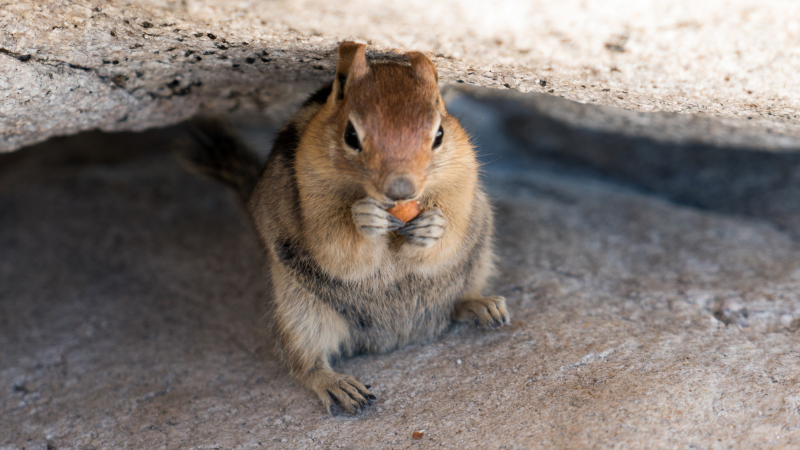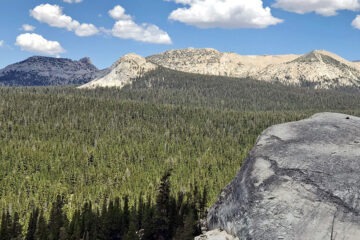Pete Devine, Yosemite Conservancy’s resident naturalist, shares some tips on being a good trail steward in Yosemite (and anywhere else your hiking boots might take you).
Yosemite Conservancy’s team of ace naturalists spends a lot of time on park trails. We also spend a lot of time observing the life around us – including members of our own species. We notice bear tracks in soft earth, birdsong floating down from branches … and delicate mosses trampled by hiking boots, or the silvery glint of a discarded granola bar wrapper half-buried along a creek shore.
To “Leave No Trace” (LNT) is a fundamental goal for all of our Outdoor and Custom Adventures, and we work hard to make sure our groups are prepared to minimize their impacts on the frontcountry and the deeper wilderness. Not everyone who visits Yosemite gets a crash course in LNT ethics before they hit the trails, though.
As a longtime outdoor leader (and LNT Master Educator), I’m well-acquainted with the detrimental impacts that the actions of hikers and backpackers can have on wild places — and with how basic LNT principles can prevent much of that harm. With a few simple steps, any Yosemite adventurer can help protect our park.
Here are a few suggestions for easy ways to avoid adverse actions and become a successful trail steward on your next hike!

- Adverse action: Cutting switchbacks
- Why it matters: Crews work hard to build and maintain trails that protect habitat while providing access to Yosemite’s scenic wonders and blissful backcountry. Short-cutting between switchbacks fosters erosion that then requires more trail work.
- Steward solution: Stay on the trails whenever possible, and especially where they’re zig-zagging on a steep slope.

- Adverse action: Stepping off a water-logged trail to follow an informal parallel route forged by prior hikers
- Why it matters: Deep, damaging ruts can form when too many people try to avoid water and mud by stepping just to the side of a wet trail and treading the same impromptu path.
- Steward solution: If it’s truly too deep to walk through in your hiking boots, walk 10-15 yards away from the trail, and continue forward until you’re able to rejoin at a drier section. If you see footprints from other hikers, take a different route. If you’re in a group, spread out. The goal is for each person to make a solo path that will recover quickly, rather than a single, heavily trodden trench that will take much longer to heal. (Donor-funded projects are making a difference with this issue on the John Muir Trail in Lyell Canyon and other places.)

- Adverse action: Feeding wildlife (either deliberately, or inadvertently, by dropping stray peanuts and raisins or leaving food unattended during a lunch break)
- Why it matters: No matter how cute and photogenic a wild animal is – we all know those pudgy squirrels and charmingly ornery jays – it’s still wild. Giving animals access to our trail snacks encourages them to grow accustomed to human food.
- Steward solution: Be vigilant about food storage! If you’re downing a handful of trail mix, make sure every last bit either goes in you, or in a litter bag. If you drop an M&M, pick it up. (The same holds true for any kind of litter – we naturalists pick up many pounds of trash along the trails every year, but would rather see it packed out before we get to it!) Stopping for a picnic? Keep your food within arm’s reach. If you’re camping, use a bear-proof locker or canister to stash your snacks.

- Adverse action: Disrupting fellow hikers – whether by blocking the trail, blaring music or deciding someone else’s secluded lunch spot is the perfect place for a Frisbee game
- Why it matters: Our presence is itself part of other people’s wilderness experiences. No matter what draws people to the trails, everyone deserves the chance to experience an environment that is as close to untouched as possible.
- Steward solution: Use headphones to listen to your tunes or podcasts. If you’re stopping for a break, move to the side of the trail, or step off (onto a durable surface). Respect the solitude that others are seeking – we guarantee you’ll find your own secluded spot. The wilderness is full of them.
As Conservancy representatives, we emphasize the importance of environmental stewardship on every outing, whether we’re leading a family on a personalized half-day hike in the Valley or taking a group of backpackers deep into the Yosemite Wilderness. I hope you can join us for an adventure soon!
Want to learn more about LNT, and gain the skills to teach others how to minimize their footprint on the great outdoors? Keep an eye on our Outdoor Adventures calendar for a spring LNT training trip.
Above: A hiker follows the trail to Mount Dana, on Yosemite’s eastern edge (south of Tioga Pass). Photo: Yosemite Conservancy/Keith Walklet



